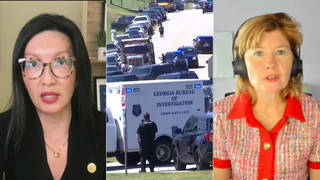
Topics
Today, California’s Pelican Bay State Prison is on lockdown in the aftermath of the bloodiest uprising in the prison’s ten-year history. [includes rush transcript]
Pelican Bay is located twenty miles south of the Oregon border and about 290 miles north of San Francisco. The facility houses over 3,400 inmates. 1,200 of them are in permanent lockdown conditions.
A clash between 200 black and Latino inmates ended in a hail of gunfire Wednesday. Guards killed one prisoner and wounded sixteen. Another thirty-two inmates suffered stab and slashing wounds. After the riot, guards searched the yard and found eighty-eight weapons, including shanks, makeshift knives made out of everything from pieces of metal to a sharpened toothbrush.
Inmates had been on lockdown since August, when a fight had erupted between black and white inmates.
Prison rights advocates note the timing of this week’s incident at Pelican Bay. The day of the uprising, two former guards were charged with violating the civil rights of Pelican Bay inmates. A federal grand jury indictment made public Wednesday accused the men of arranging assaults on prisoners over a three-year period. One of those assaults was fatal. And last week, another guard was convicted of civil rights charges for shooting a prisoner after a fight in 1994.
Guests:
* Leslie Dibenedetto, Chair of the Pelican Bay Committee of California Prison Focus, a San Francisco-based human rights activist group. Call: 415.252.9211.
* Luis Talamantez, co-founder, California Prison Focus. He is an ex-con known on the inside as “Bato.” He focuses on ways to bring about racial harmony among prisoners. The warden refuses to allow him in the prison.
* Name Withheld, former prisoner at Pelican Bay Prison.
Related link:
* California Prison Focus
Transcript
AMY GOODMAN: We have so much to do. We’re going to move quickly on, because so much is happening in California. California prison officials now say guards wounded fifteen prisoners, shot fifteen prisoners and killed one, when they opened fire, they say, to stop a riot. The general population of Pelican Bay State Prison remains locked down after yesterday’s battle between 200 black and Hispanic prisoners. Another thirty-two prisoners suffered stabbing or beating injuries. At least one prisoner is in critical condition. No guards were wounded.
Today, we’re going to take a look at California’s Pelican Bay State Prison, located twenty miles south of the Oregon border, about seven miles’ drive north of San Francisco. The facility houses 3,400 prisoners. 1,200 live in permanent lockdown.
We’re joined by two people who know this prison well: Leslie DiBenedetto is chair of the Pelican Bay Committee of California Prison Focus, which is a San Francisco-based human rights activist group; and Luis Talamantez is with us, co-founder of California Prison Focus. He served time in prison about a quarter of a century ago. Inside, he’s known as “Bato.” He focuses on ways to bring about racial harmony among prisoners. He’s not allowed into the Pelican Bay State Prison by the current warden.
Let’s start with you, Luis. Tell us about your picture. I pretty much just read the prison authorities’ picture of what happened yesterday at Pelican Bay, because that’s all the newswire quotes.
LUIS TALAMANTEZ:
Amy, it’s wake-up time in California. This has been long in coming. We’ve been talking about an Attica sooner or later here in the mammoth prison system of California, which has thirty-four prisons currently in operation. And it’s been coming, you know, that this didn’t happen earlier somewhere else, you know. It happened at Pelican Bay. And Pelican Bay, right from the beginning, Amy, when it was opened in '89 to today, which marks the ten year since the opening of Pelican Bay and the reign of terror that has taken place there over this decade. So we're at a point that when it opened, it was opened and built on violence. They perform violence, practice violence, perpetuate violence. The place is a violent place, institution. To this day, nothing has changed, except that the violence has increased, and it’s shown itself in just different horrible ways, such as this mass shooting that took place Wednesday.
AMY GOODMAN:
Well, tell us — the prison authorities say it’s a race riot. Can you talk about what’s going on within the prison, how they say the prisoners had something like — they uncovered eighty-eight weapons, and why groups like yours aren’t allowed in?
LUIS TALAMANTEZ:
Well, yeah. Well, eighty-eight weapons, we want to know, first of all, where did the weapons come from? And yes, it was a racial brawl. And now we’re understanding that on the yard all races were present. And yet, they say it was a Hispanic-black conflict. But the whole place, the whole prison is in conflict. In August of last year, it was the biggest riot ever in the department’s history, and that was between blacks and whites, OK? So it has manifested itself, this locked-up rage and violence in Pelican Bay, which they attribute so heavily to prisoners by calling them the worst and worst and worst, but yet, which — you know, in that institution, violence is there, and it just manifests itself in different ways. In this instance, those 200 guys on the B-yard, and a friend of mine who also did time with me said, “Bato, if you’re on the yard when something like that goes down, then you’re in it, whether you want to be or not.” So my heart goes out to the guys who were on that yard fighting for their lives, probably not even knowing why they were fighting each other, but fighting for their lives. OK?
AMY GOODMAN:
Well, let’s bring Leslie DiBenedetto into the conversation. Yesterday, you were telling me about a quote in the paper of one of the guards talking about — or one of the staff people talking about tension and who it serves.
LESLIE DiBENEDETTO: Right. Yeah, there was a one-year lockdown on another Level 4 prison, which is one of our high-security general population units in California, which resulted in a hunger strike of about, I think, sixty prisoners. And one of their demands was to be allowed back on the yard with other prisoners that they got along with. And the person that was negotiating with them, his name is Ken Hurdle, he’s actually an ombudsman for the Department of Corrections, which means that he’s supposed to be working as a liaison between prisoners and staff. His quote was —- basically said, “Then you’d have two groups normally aligned on the yard at the same time. They would only have staff as their enemy.” So basically the thinking is, you know, we need to have rival groups on the yard, rival, you know, people who don’t necessarily get along on the yard, so that they can fight themselves, so that we, you know -—
AMY GOODMAN:
So they don’t fight the staff.
LESLIE DiBENEDETTO: Right, exactly.
AMY GOODMAN:
Alright. We only have two minutes to go, and for listeners —
LESLIE DiBENEDETTO: I actually wanted to —
AMY GOODMAN:
Go ahead.
LESLIE DiBENEDETTO: — let you talk to someone very briefly. He’s a friend of mine who was in Pelican Bay on the general population yard in 1995. And he just wanted to make a couple quick comments about —
AMY GOODMAN:
OK.
LESLIE DiBENEDETTO: …his analysis. Hold on.
AMY GOODMAN:
You’re listening to Pacifica Radio’s Democracy Now!
UNIDENTIFIED: Hello, how you doing?
AMY GOODMAN:
Hi. Thanks for being with us. What’s your name?
UNIDENTIFIED: Well, for security reasons and, you know, fear of retribution, I prefer not to disclose that information right there.
AMY GOODMAN:
Well, we only have two minutes to go left on the show, but can you describe what life was like at Pelican Bay?
UNIDENTIFIED: Well, for different prisoners, it was — if you have — you have to understand that in Pelican Bay, you have different classes of prisoners. You have politically conscious prisoners, then you have the politically unconscious. And you have different ways that prisoners are evaluated and placed on different programs while in Pelican Bay. So if you’re classified in a particular category, then the way you’re treated by the administration could be, you know, fundamentally different from a prisoner who’s opposite in his thinking.
AMY GOODMAN:
In the last few days, it’s very important to note what’s happened before this so-called race riot. Two former guards were charged with violating the civil rights of Pelican Bay inmates. A federal grand jury indictment was made public Wednesday, accusing them of arranging assaults on prisoners over a three-year period, and one of those assaults was fatal. Last week, another guard was convicted of civil rights charges for shooting a prisoner after a fight in ’94. Does this sound like the prison that you were in?
UNIDENTIFIED: Oh, yes, most definitely. I personally witnessed guard brutality, as well as collaboration between certain prisoners and guards to attack and maim prisoners while I was in Pelican Bay. So it was definitely a relationship that exists in that type of environment up in Pelican Bay State Prison.
AMY GOODMAN:
Given the information you’ve gotten, and it’s tough to get information out of a prison when there’s this kind of situation, when you only get it from the authorities, what is your assessment of what happened in the last two days?
UNIDENTIFIED: Well, my assessment thus far is, first of all, I haven’t had the opportunity to do a concrete investigation, but the information that’s coming out of Pelican Bay, as well as Sacramento, is controlled. And I don’t buy for one minute that a riot existed on the yard for thirty minutes, because the guards in Pelican Bay have had been trained to use lethal force immediately in order to defuse an incident there. Just recently, they implemented new shooting procedures, which kind of put guards in check, in terms of breaking up fistfights with live gunfire. So the thirty-minute riot incident is kind of unbelievable.
AMY GOODMAN:
Well, on that note we do have to end the discussion, but we’ll continue to pursue what happened there and hope to get more word out from inside the prison. This following what has taken place in Corcoran over the last year, another high-security prison in California where guards would bring rival gang members into the yard at the same time, known sworn enemies, they would get in a fight, and then they would shoot one of them, the guards would shoot one of them dead.
Thanks for being with us. Leslie DiBenedetto, thanks for setting that up, chair of the Pelican Bay Committee of California Prison Focus, and Luis Talamantez, we will speak again since we didn’t have enough time to speak this time, co-founder of California Prison Focus.













Media Options